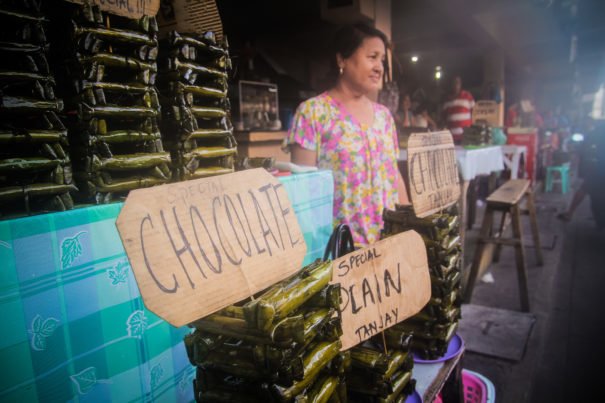
Drown Your Weather Sorrows in Thick Hot Chocolate

Drown Your Weather Sorrows in Thick Hot Chocolate
Bodbod kabog in Dumaguete
The weather forecast announced there would be a typhoon in the next three days. A super-typhoon, in fact. But this warning was not unusual in the Philippines, a country where almost 20 tropical storms pass each year, around half of them making landfall.
In the seaport city of Dumaguete, people were unfazed. The relaxed university town at the edge of Visayas province was our jumping-off point for the beaches of Siquijor Island, and I was worried that the next day’s boat trips would be cancelled due to inclement weather. Yet Saturday night passed without incident. Locals and tourists filled the bars along the harbor, despite a downpour so thick you couldn’t see 10 feet ahead. It didn’t stop until we woke to a bright Sunday morning. We furtively watched grey clouds on the horizon as we hailed a tricycle.
“Where?” The driver asked. “Bodbod kabog?” I replied uncertainly—a local delicacy, not a destination. He drove us to Dumaguete’s public market. Bodbod kabog, a close cousin to the more popular Filipino rice cake suman, is Dumaguete’s quintessential breakfast: a sticky-sweet log of millet seeds and coconut milk steamed in banana leaf. It’s nutty, chewy, and creamy all at once.
At 6 am, the market was bustling. There were more motorcycles than people, being driven by teenagers and grandmothers alike, deftly maneuvering between vendors and shoppers. The faint smell of fish dissipated as we walked past stalls of dry goods. Eventually, the stalls gave way to bustling counters piled high with bodbod kabog.
Vendors cheerfully called out to us, singsong voices rising and falling in a noisy din. We were overwhelmed by the sudden attention until one elderly lady, smiling behind her crowded counter, silently beckoned us closer. We bought two bodbod kabog for 12 pesos—roughly 12 cents.
The best (and only) accompaniment to bodbod is tsokolate—Filipino hot chocolate—made with local blocks of cacao. Tsokolate is either thick or watery, and it’s often the latter. This is a truth so well-known that our national hero, Jose Rizal, wrote about it in his 1886 novel, Noli Me Tangere: A town mayor tells some visiting Spaniards that if they go to see the parish priest and he orders the servant to make them a cup of tsokolate eh (thick), they should stay without fear, but if he tells the servant to make them a cup of tsokolate ah (watery), they should take their hats and run.
The elderly lady’s tsokolate was delightfully eh, approaching the consistency and smoothness of churro dip. I swirled the bodbod in it out of instinct. She approved this gesture by slyly adding another to my plate.
We stayed long after we settled our bill, listening to fellow diners chat the morning away, determined to face the impending storm with as much nonchalance as they were. Turns out they had it right: it didn’t rain once until our flight back home to Manila.